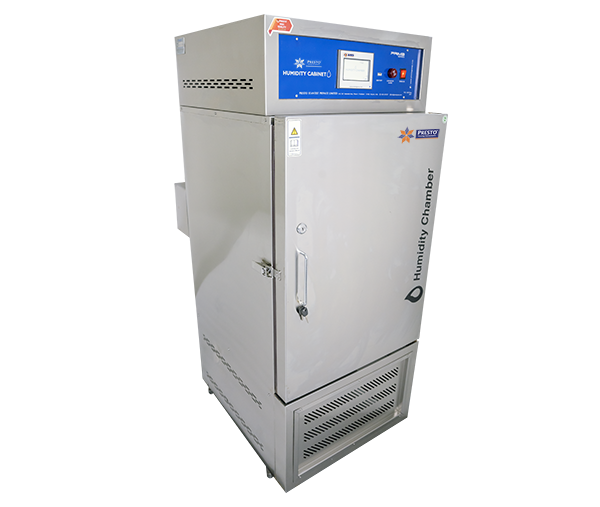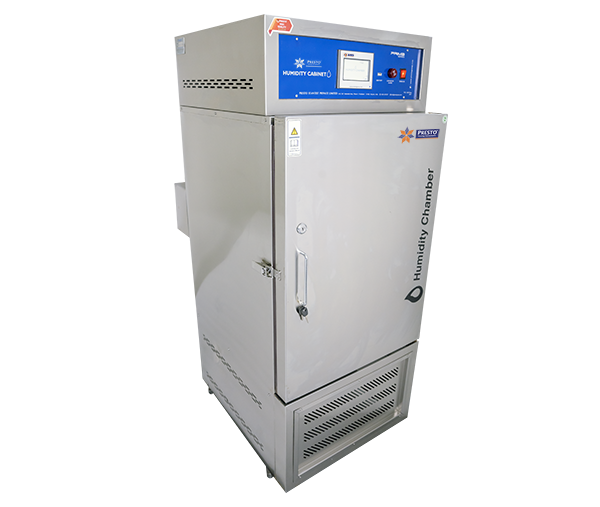A Complete Guide to Humidity Chambers: Working Principle, Uses, and Price Considerations

When it comes to testing the durability and performance of materials under varying environmental conditions, a humidity chamber plays a crucial role. Industries ranging from electronics to pharmaceuticals rely on these chambers to simulate conditions of high humidity and temperature to assess how their products perform in real-world conditions. But what exactly is a humidity chamber? How does it work, and why is it so essential for various testing applications? In this blog, we’ll discuss the humidity chamber working principle, its various uses, and factors affecting the humidity chamber price. Additionally, we’ll answer some frequently asked questions to help you better understand the purpose and functionality of this vital testing instrument.

What is the Use of a Humidity Chamber?
A humidity chamber is used to simulate environments with controlled levels of humidity and temperature to test how various materials or products react to these conditions. This is particularly important for industries such as electronics, packaging, textiles, and pharmaceuticals, where product durability in different environmental conditions is critical.
For instance, electronic components are highly sensitive to moisture, and a humidity chamber allows manufacturers to evaluate how these components will perform when exposed to high humidity levels. Similarly, the automotive industry uses humidity chambers to test the corrosion resistance of metal parts.
What is Humidification Chamber?
A humidification chamber is another term often used interchangeably with a humidity chamber, although it refers specifically to the process of creating a moist environment for testing purposes. In a humidification chamber, controlled humidity is introduced to simulate conditions that the product might encounter in real-world settings.
The purpose of these chambers is to maintain a consistent moisture level to replicate environmental conditions that could lead to material degradation, corrosion, or malfunction. Whether it's for packaging, electronics, or metal parts, humidification chambers help manufacturers improve product reliability by identifying weaknesses before the product reaches the consumer.
Humidity Chamber Working Principle
The humidity chamber working principle is fairly straightforward but highly effective. The chamber contains a controlled environment where humidity and temperature can be precisely regulated to meet specific test requirements. The basic process involves heating water to create steam, which is then circulated throughout the chamber to maintain a desired humidity level. Simultaneously, temperature controls ensure that the chamber remains at the set temperature, whether it’s high or low.
Modern humidity chambers are equipped with sensors and digital control systems that constantly monitor and adjust humidity and temperature levels to maintain consistent conditions. This helps ensure that the test results are accurate and reliable. Some chambers also feature programmable settings that allow users to simulate different environmental cycles, such as periods of high humidity followed by dry conditions.
How Do You Control Humidity in a Chamber?
Controlling humidity in a humidity chamber is crucial for accurate testing. Most chambers come equipped with a sophisticated humidification system that involves heating water to create vapor, which increases the humidity level inside the chamber. These systems also feature dehumidifiers to remove excess moisture if the levels go above the desired range.
Modern chambers offer digital control panels where users can set the exact humidity level they need, typically between 20% to 95% relative humidity (RH), depending on the type of test being conducted. Sensors within the chamber continuously monitor the environment, making adjustments as needed to maintain the specified humidity and temperature conditions. Some chambers even allow users to program multiple cycles with varying humidity levels to simulate changing environmental conditions over time.
Why Do We Use a Moist Chamber?
The use of a moist chamber (or humidity chamber) is essential for determining how products will perform in high-humidity conditions. A moist chamber simulates the type of environments that can cause materials to degrade, corrode, or malfunction. Products such as medical devices, electronics, and automotive parts are tested in moist chambers to ensure they can withstand exposure to humid environments without losing functionality or quality.
For example, in the medical industry, packaging for sterile products must be tested in moist chambers to verify that the packaging will hold up in humid environments without compromising the sterility of the contents. Similarly, moisture-sensitive electronic components are tested to ensure that they won’t degrade or short-circuit when exposed to humid conditions.
Humidity Chamber Price Considerations
The humidity chamber price can vary significantly based on factors such as the chamber's size, features, and performance capabilities. Smaller chambers designed for testing individual components or materials will generally cost less, while larger chambers capable of testing bulk products or running more complex environmental simulations will have a higher price tag.
Other factors that influence the price include the range of humidity and temperature control, the inclusion of programmable settings, and additional features like data logging and automatic calibration. It’s also important to consider the quality of the materials used in constructing the chamber, as well as the after-sales service and warranty offered by the manufacturer.
While initial costs might seem high, investing in a quality humidity chamber from a reputable manufacturer ensures long-term reliability and accuracy, which can lead to cost savings over time through improved product quality and fewer recalls.
A humidity chamber is an invaluable tool for manufacturers in industries like electronics, pharmaceuticals, packaging, and automotive. It simulates real-world environmental conditions, helping companies ensure that their products can withstand high humidity levels without degrading or failing. Understanding the humidity chamber working principle is key to selecting the right chamber for your needs. Additionally, the humidity chamber price will depend on the size, features, and precision of the model you choose.
When selecting a humidity chamber, consider factors such as control accuracy, chamber size, and advanced features like programmable cycles and data logging. A well-chosen humidity chamber can improve your product testing process, leading to higher-quality products and greater customer satisfaction.
- Art
- Causes
- Crafts
- Dance
- Drinks
- Film
- Fitness
- Food
- Игры
- Gardening
- Health
- Главная
- Literature
- Music
- Networking
- Другое
- Party
- Religion
- Shopping
- Sports
- Theater
- Wellness
- IT, Cloud, Software and Technology


